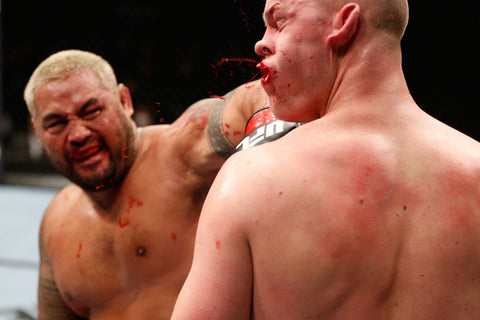I Might Have a Concussion, But at Least I Don't Have a Concussion

Photo Courtesy of MMAFighting.com
Sports related head injuries are in the spotlight like never before. Once confined to discussions about the dangers of boxing, concussions are now part of the daily discourse when examining their prevalence in all contact sports, including football, hockey and even sports entertainment, like professional wrestling. Tragically, chronic traumatic encephalopathy, or CTE, has been implicated in the deaths of prominent athletes Junior Seau and WWE wrestler Chris Benoit.
Mixed Martial Arts practitioners and promoters have long touted their sport as being less dangerous than boxing and the like due to a lack of standing eight-count allowing concussed fighters to continue, and the number of fights that end in submissions instead of knockouts. One early study regarding MMA injuries stated that lacerations were the predominant injury in MMA, lending strength to the argument that professional mixed martial arts bouts were safer. A more recent report revealed that MMA fighters are not immune to the dangers of concussions.
To protect themselves, athletes have used protective head gear in order to decrease their likelihood of concussive injury. To do so, however, is to misunderstand the mechanics of a brain injury. Headgear will protect the face and head from trauma, but in order to decrease the chance of a concussion, you have to be able to reduce the rotational component of the injury. It isn’t the strike to the head that causes the concussion, but the rotation of the head on the neck. This causes the brain to, in essence, slide and strike up against the sides of the skull. In theory, if you can decrease the rotation, you can decrease your chances for brain injury.
What follows are exercises to strengthen the neck and upper shoulders. No program will make you immune to concussions. These are designed to maximize the strength of the muscles surrounding your cervical spine to decrease your risk of injury. As always, consult your physician before beginning any exercise routine, particularly if you have suffered a neck injury in the past.
Deep Neck Flexor Lifts
Lie supine (face up) on the floor. Tuck your chin down towards your throat. Slowly lift your head from the floor as if you are bringing your chin to your chest without losing the chin tuck. Hold, and then slowly lower back to the floor. Flexing your neck and lifting your head against gravity strengthens the muscles in the front of your cervical spine. Perform 30 repetitions. For a greater challenge, lie on a table with your head suspended in the air and perform as above.

Prone Neck Retractions
Lie prone (face down) on a table with your head off the edge. Pull your head back, tucking your chin to your throat. Perform 30 repetitions. Retracting your head against gravity will work the muscles that run along the sides of your cervical spine.
YTI’s
Named for the position of your arms in relation to your body, these exercises target the middle and lower trapezius muscles, taking strain off your cervical spine by strengthening your upper back. Lie prone on a table or an incline bench with two low weight dumbbells. Bring your arms overhead in a “Y” position, hold, and then return to your sides. Perform 30 repetitions. Next bring your arms out to the side, thumbs up, in a “T” position. Hold, and then return to your sides. Perform 30 repetitions. Finally, lift your arms straight up behind you in an “I” position. Hold, and then return to your sides. Perform 30 repetitions.

Written By John Vercher
John is a writer and physical therapist with over ten years of sports medicine and orthopedics experience. He has competed as an amateur in kickboxing and MMA and continues to compete in jiu-jitsu tournaments year round.
Have any questions for John Vercher about Injury Prevention? Leave them in the comments below...
